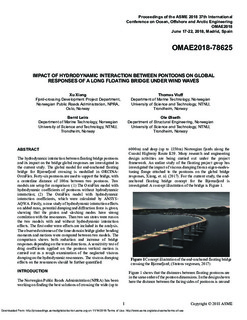Impact of Hydrodynamic Interaction Between Pontoons on Global Responses of a Long Floating Bridge Under Wind Waves
Chapter
Published version
Permanent lenke
http://hdl.handle.net/11250/2584947Utgivelsesdato
2018Metadata
Vis full innførselSamlinger
- Institutt for konstruksjonsteknikk [2470]
- Institutt for marin teknikk [3421]
- Publikasjoner fra CRIStin - NTNU [37703]
Originalversjon
10.1115/OMAE2018-78625Sammendrag
The hydrodynamic interaction between floating bridge pontoons and its impact on the bridge global responses are investigated in the current study. The global model for end-anchored floating bridge for Bjørnefjord crossing is modelled in ORCINA-OrcaFlex. Forty-six pontoons are used to support the bridge, with a centerline distance of 100m between two pontoons. Two models are setup for comparison: (1) The OrcaFlex model with hydrodynamic coefficients of pontoons without hydrodynamic interaction; (2) The OrcaFlex model with hydrodynamic interaction coefficients, which were calculated by ANSYS-AQWA. Firstly, a case study of hydrodynamic interaction effects on added mass, potential damping and diffraction force is given, showing that the piston and sloshing modes have strong correlation with the resonances. Then two sea states were run on the two models with and without hydrodynamic interaction effects. The first order wave effects are included in the analysis. The observed extremes of the time-domain bridge girder bending moments and motions were compared between two models. The comparison shows both reduction and increase of bridge responses depending on the wave directions. A sensitivity test of drag coefficients applied on the pontoon vertical motion is carried out as a rough examination of the neglected viscous damping on the hydrodynamic resonances. The viscous damping effects on the resonances should be further quantified.
